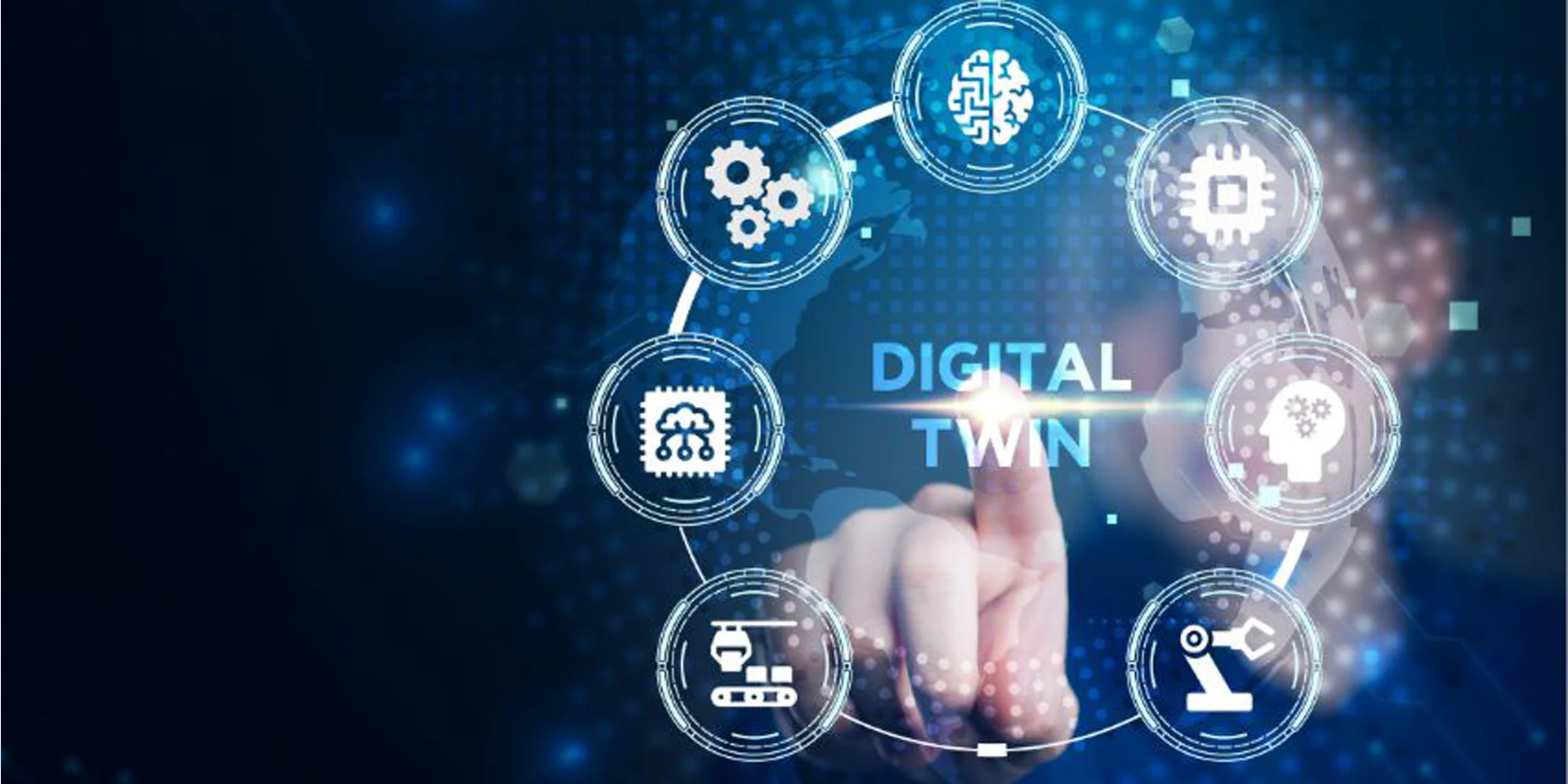Necessary Always Active
Necessary cookies are required to enable the basic features of this site, such as providing secure log-in or adjusting your consent preferences. These cookies do not store any personally identifiable data.
|
||||||
|
||||||
|
||||||
|

Imagine having a virtual copy of your machines or systems that you can monitor and analyze without needing to touch the physical equipment. That’s what Digital Twin technology offers—a detailed, real-time digital mirror of your assets. This technology isn’t just a buzzword; it’s transforming how industries approach two important areas: predictive maintenance and asset management.
Digital twin builds on the power to anticipate issues before they arise and streamline the management of assets. This proactive approach helps companies save time, reduce costs, and improve efficiency. In this post, we explore how exactly this innovative technology is changing the game.
Digital Twin is a data-driven virtual representation of a physical object – whether it’s a factory, a cooling system, or even a piece of IT infrastructure.
It’s a detailed simulation that uses a two-way flow of information powered by data collected from sensors and when insights are shared back by the system processor with the original source object.

The data is then fed into a virtual model that helps you understand how the asset is behaving. The beauty of a Digital Twin is that it lets maintenance teams experiment in a virtual space, testing adjustments and fixes digitally before applying them in the real world. It’s like being able to practice on a prototype before doing surgery on a real patient.
The journey of Digital Twin technology began when Ivan Sutherland developed the first Computer Aided Design (CAD) software called SKETCHPAD at MIT. This breakthrough allowed engineers to design and model assets digitally, cutting down the need for physical prototypes.
Fast forward to today’s Industry 4.0 era, technologies like the Internet of Things, and data analytics have taken Digital Twin to new heights. These advancements are now helping businesses make smarter and more sustainable decisions through predictive maintenance.
Predictive maintenance is all about staying ahead of the game when it comes to keeping equipment running smoothly. Instead of waiting for something to break down or doing routine checks, predictive maintenance uses real-time data to predict when a machine may need attention.
The sensors track things like temperature, vibration, and wear, allowing companies to spot issues early and fix them before they lead to costly downtime.
In addition, predictive maintenance leverages data from sensors, using advanced tools like Artificial intelligence and machine learning to predict equipment conditions and minimize risk.
Predictive maintenance always aims to foresee equipment issues before they reach a critical level, and Digital Twin technology is taking this approach to a whole new level. Here’s how the new technology is making an impact:
1. Predictive Issue Detection: Digital Twins constantly monitor your machines using data from sensors to predict when something might go wrong. This helps maintenance teams jump in and fix problems before they escalate, ultimately reducing the risk of costly breakdowns and helping companies allocate their resources more effectively.
2. Optimized Maintenance Scheduling: Digital Twins help companies figure out the best times for maintenance based on actual conditions rather than sticking to a calendar. This means repairs happen exactly when they’re needed, reducing unnecessary downtime and keeping everything running smoothly.
3. Extended Equipment Lifespan: Digital Twin prolongs the life of equipment through the prevention of problems and keeping assets in their top condition. These digital replicas address wear and tear before it escalates ensuring your machinery lasts longer and operates more efficiently.
When it’s finally time to retire an asset, Digital Twins can even assist in planning for its disposal, like sorting recyclable parts or finding the most eco-friendly way to dispose of it.
4. Better Design and Testing: Digital Twins also shine when it comes to design and testing. Companies can use them to simulate how different designs will perform, allowing for tweaks and improvements before a physical product is even created. This not only saves time but also means that products are optimized right from the start.
Asset management is simply the process of planning and controlling the development, operation, maintenance, and disposal of an asset. This process is often aimed at improving the performance of the asset using the most cost-effective method.
When asset management is carried out properly, it leads to an extended lifecycle of assets, delaying the need for costly replacements. In the long term, it increases the company’s return on Investment.

Digital Twin has significantly impacted how businesses manage their assets and make smarter decisions. Here are some of the key ways it’s making a difference:
1. Better Asset Performance: Digital twins go a step further in that they involve not just the prediction of the timing of maintenance, but also performance trends over a period. The analysis of these performance trends allows asset managers to identify the inefficiencies and make appropriate decisions to continually optimize asset performance. This helps ensure assets operate at their peak for longer periods.
2. Improved Maintenance Planning: Probably one of the most attractive features of Digital Twin technology is the fact that it allows the testing of implementation in advance before trying to provide changes in real life. Maintenance teams can test different scenarios and tweak parameters in a virtual environment.
This ensures that any modifications are thoroughly assessed for impact, reducing the risk of unintended consequences on physical assets. For instance, if a company wants to change the operational settings of a piece of equipment, they can use Digital Twin to test how it would perform before making any changes in reality. This results in smarter, and more effective planning.
3. Cost Optimization: With Digital Twins, there’s a lesser need for physical testing and this saves companies a lot. Additionally, the technology provides data to optimize energy efficiency and reduce production downtime, enabling further cost savings. Even employee training can be streamlined, as virtual simulations can be used instead of real training on expensive equipment.

4. Improved Safety and Reliability: Digital Twin enables real-time data monitoring of an asset, improving its safety and reliability. For any identification of safety risks, alarms go off and maintenance teams can intervene before any potential hazard escalates. This feedback loop is very important in industries where safety is one of the main issues.
5. Data-driven Decision Making: Sensors and IoT devices feed Digital Twins with a wealth of real-time data. This allows teams to make quick, informed decisions regarding maintenance and performance optimization. Instead of relying on guesswork or periodic checks, data is always available, ensuring assets are well-managed and optimized for the best performance.
5. Effective Resource Allocation: Digital Twins also allow businesses to be more precise with resource allocation. Whether it’s energy, manpower, or materials, companies can simulate various scenarios to determine the most efficient use of resources.
This precision reduces waste and maximizes productivity, improving overall operational efficiency. For example, in a large manufacturing plant, Digital Twins can predict when specific machines need extra attention, helping managers allocate staff and materials more efficiently, reducing costs, and boosting productivity.
Digital Twin technology is already making a big impact on predictive maintenance and asset management. It allows businesses to catch problems early on, fine-tune their maintenance schedules, and get the most out of their assets.
As we look ahead, it’s exciting to think about how this technology will reshape our approach to managing equipment, making operations more reliable and efficient. The best part? It’s not some distant future— this transformation is happening right now.
Sign up to receive our newsletter featuring the latest tech trends, in-depth articles, and exclusive insights. Stay ahead of the curve!